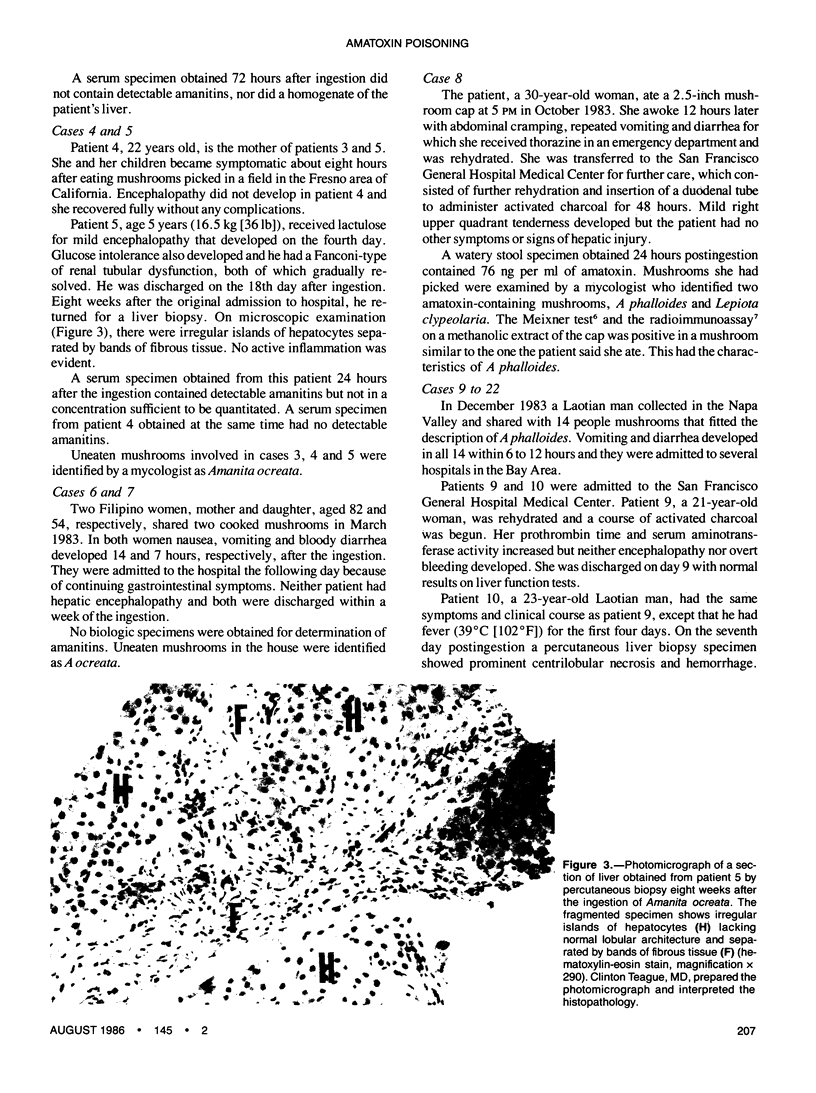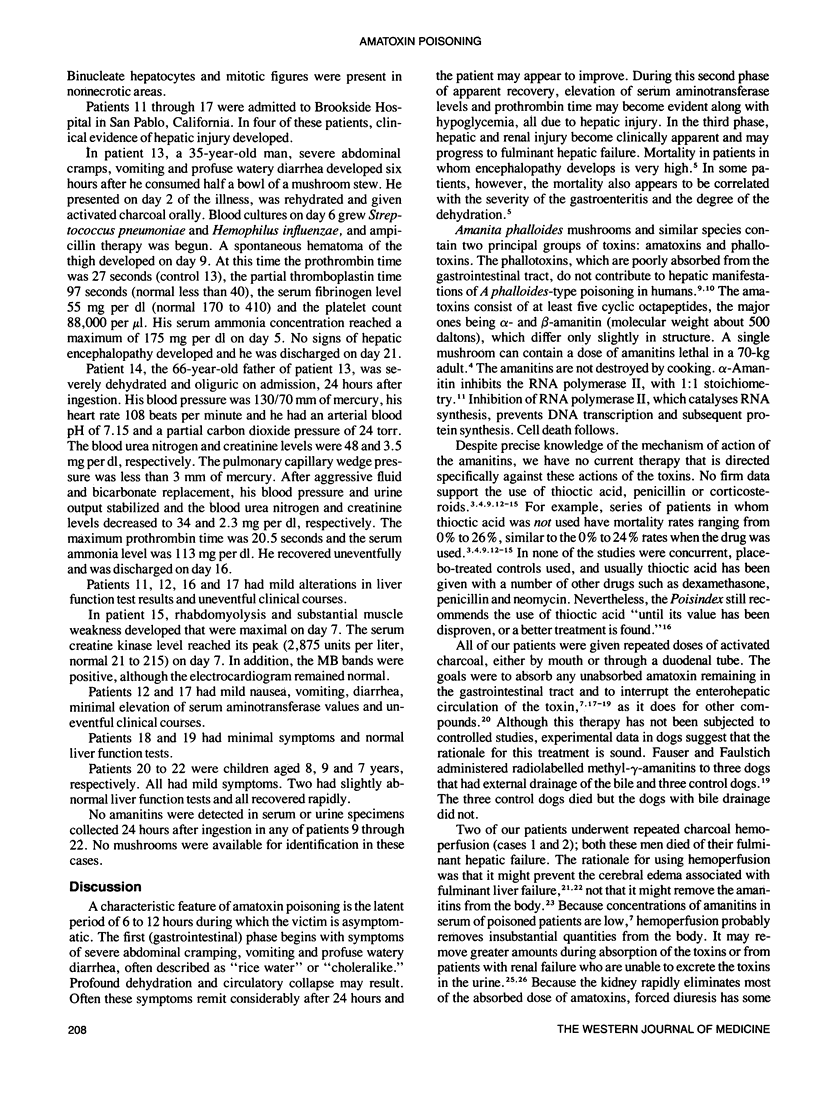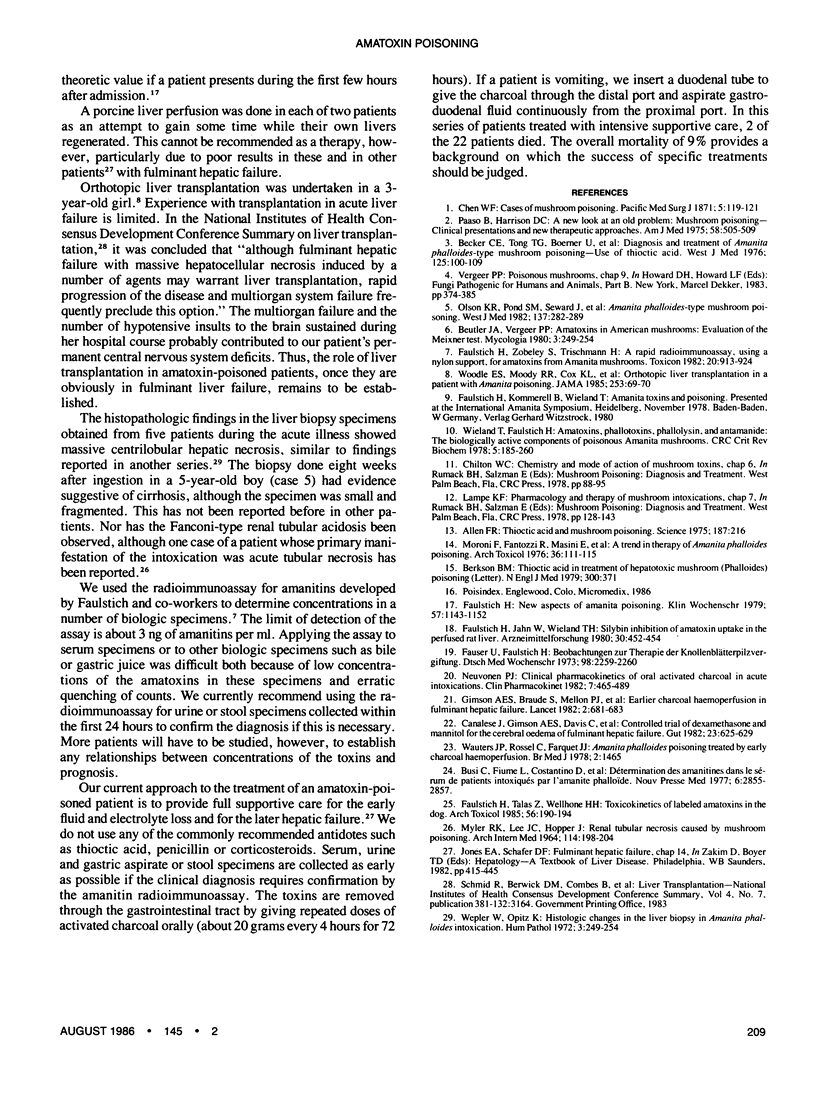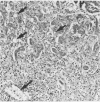Abstract
Twenty-two patients who ate mushrooms containing hepatotoxic amatoxins were treated during the fall and winter seasons of 1982 and 1983. All patients were treated with intensive supportive care and repeated oral doses of activated charcoal. In two patients fulminant hepatic failure developed and they died. One patient in whom encephalopathy developed had an orthotopic liver transplant and survived. Liver biopsy specimens obtained from five patients during the acute illness showed centrilobular hemorrhagic necrosis. The hepatic histopathology in a biopsy specimen from a 5-year-old boy eight weeks after mushrooms were eaten showed bands of fibrosis and islands of hepatocytes suggestive of early cirrhosis. Radioimmunoassay for amanitins, done on the serum from all patients, detected the toxins in only three, probably because most of the specimens were obtained 24 hours or more after the ingestion. This series, with a mortality rate of 9%, illustrates the outcome in patients who receive intensive supportive care and provides a background on which success of specific treatments should be judged.
Full text
PDF





Images in this article
Selected References
These references are in PubMed. This may not be the complete list of references from this article.
- Alleva F. R. Thioctic Acid and mushroom poisoning. Science. 1975 Jan 24;187(4173):216–216. doi: 10.1126/science.187.4173.216. [DOI] [PubMed] [Google Scholar]
- Becker C. E., Tong T. G., Boerner U., Roe R. L., ScoTT A. T., MacQuarrie M. B., Bartter F. Diagnosis and treatment of Amanita phalloides-type mushroom poisoning: use of thioctic acid. West J Med. 1976 Aug;125(2):100–109. [PMC free article] [PubMed] [Google Scholar]
- Berkson B. M. Thioctic acid in treatment of hepatotoxic mushroom (Phalloides) poisoning. N Engl J Med. 1979 Feb 15;300(7):371–371. doi: 10.1056/NEJM197902153000723. [DOI] [PubMed] [Google Scholar]
- Busi C., Fiume L., Costantino D., Borroni M., Ambrosino G., Olivotto A., Bernardini D. Détermination des amanitines dans le sérum de patients intoxiqués par l'amanite phalloïde. Nouv Presse Med. 1977 Oct 1;6(32):2855–2857. [PubMed] [Google Scholar]
- Canalese J., Gimson A. E., Davis C., Mellon P. J., Davis M., Williams R. Controlled trial of dexamethasone and mannitol for the cerebral oedema of fulminant hepatic failure. Gut. 1982 Jul;23(7):625–629. doi: 10.1136/gut.23.7.625. [DOI] [PMC free article] [PubMed] [Google Scholar]
- Faulstich H., Jahn W., Wieland T. Silybin inhibition of amatoxin uptake in the perfused rat liver. Arzneimittelforschung. 1980;30(3):452–454. [PubMed] [Google Scholar]
- Faulstich H. New aspects of amanita poisoning. Klin Wochenschr. 1979 Nov 2;57(21):1143–1152. doi: 10.1007/BF01491754. [DOI] [PubMed] [Google Scholar]
- Faulstich H., Talas A., Wellhöner H. H. Toxicokinetics of labeled amatoxins in the dog. Arch Toxicol. 1985 Jan;56(3):190–194. doi: 10.1007/BF00333425. [DOI] [PubMed] [Google Scholar]
- Faulstich H., Zobeley S., Trischmann H. A rapid radioimmunoassay, using a nylon support, for amatoxins from Amanita mushrooms. Toxicon. 1982;20(5):913–924. doi: 10.1016/0041-0101(82)90079-4. [DOI] [PubMed] [Google Scholar]
- Fauser U., Faulstich H. Beobachtungen zur Therapie der Knollenblätterpilzvergiftung. Besserung der Prognose durch Unterbrechung des enterohepatischen Kreislaufs (Choledochusdrainage. Dtsch Med Wochenschr. 1973 Nov 23;98(47):2259–2259. [PubMed] [Google Scholar]
- Gimson A. E., Braude S., Mellon P. J., Canalese J., Williams R. Earlier charcoal haemoperfusion in fulminant hepatic failure. Lancet. 1982 Sep 25;2(8300):681–683. doi: 10.1016/s0140-6736(82)90711-5. [DOI] [PubMed] [Google Scholar]
- MYLER R. K., LEE J. C., HOPPER J., Jr RENAL TUBULAR NECROSIS CAUSED BY MUSHROOM POISONING. RENAL BIOPSY FINDINGS BY ELECTRON MICROSCOPY AND USE OF PERITONEAL DIALYSIS IN TREATMENT. Arch Intern Med. 1964 Aug;114:196–204. doi: 10.1001/archinte.1964.03860080046003. [DOI] [PubMed] [Google Scholar]
- Moroni F., Fantozzi R., Masini E., Mannaioni P. F. A trend in the therapy of Amanita phalloides poisoning. Arch Toxicol. 1976 Oct 28;36(2):111–115. doi: 10.1007/BF00351969. [DOI] [PubMed] [Google Scholar]
- Neuvonen P. J. Clinical pharmacokinetics of oral activated charcoal in acute intoxications. Clin Pharmacokinet. 1982 Nov-Dec;7(6):465–489. doi: 10.2165/00003088-198207060-00001. [DOI] [PubMed] [Google Scholar]
- Olson K. R., Pond S. M., Seward J., Healey K., Woo O. F., Becker C. E. Amanita phalloides-type mushroom poisoning. West J Med. 1982 Oct;137(4):282–289. [PMC free article] [PubMed] [Google Scholar]
- Paaso B., Harrison D. C. A new look at an old problem: mushroom poisoning. Clinical presentations and new therapeutic approaches. Am J Med. 1975 Apr;58(4):505–509. doi: 10.1016/0002-9343(75)90123-0. [DOI] [PubMed] [Google Scholar]
- Wauters J. P., Rossel C., Farquet J. J. Amanita phalloides poisoning treated by early charcoal haemoperfusion. Br Med J. 1978 Nov 25;2(6150):1465–1465. doi: 10.1136/bmj.2.6150.1465. [DOI] [PMC free article] [PubMed] [Google Scholar]
- Wepler W., Opitz K. Histologic changes in the liver biopsy in Amanita phalloides intoxication. Hum Pathol. 1972 Jun;3(2):249–254. doi: 10.1016/s0046-8177(72)80078-9. [DOI] [PubMed] [Google Scholar]
- Wieland T., Faulstich H. Amatoxins, phallotoxins, phallolysin, and antamanide: the biologically active components of poisonous Amanita mushrooms. CRC Crit Rev Biochem. 1978 Dec;5(3):185–260. doi: 10.3109/10409237809149870. [DOI] [PubMed] [Google Scholar]
- Woodle E. S., Moody R. R., Cox K. L., Cannon R. A., Ward R. E. Orthotopic liver transplantation in a patient with Amanita poisoning. JAMA. 1985 Jan 4;253(1):69–70. [PubMed] [Google Scholar]





